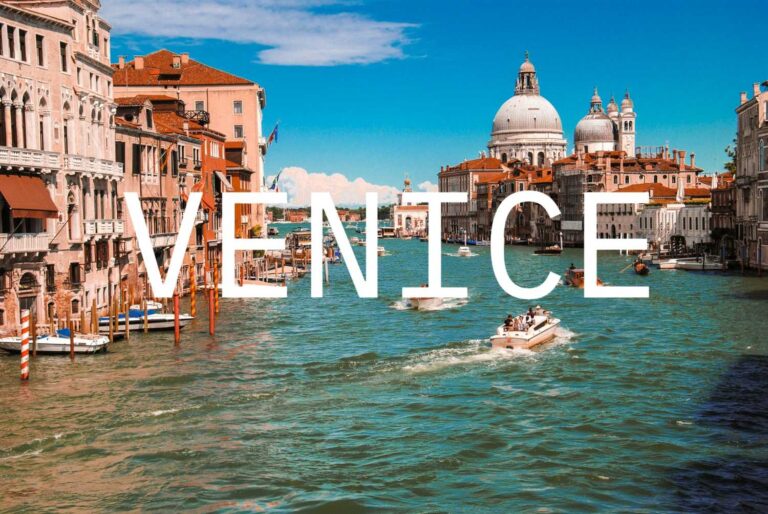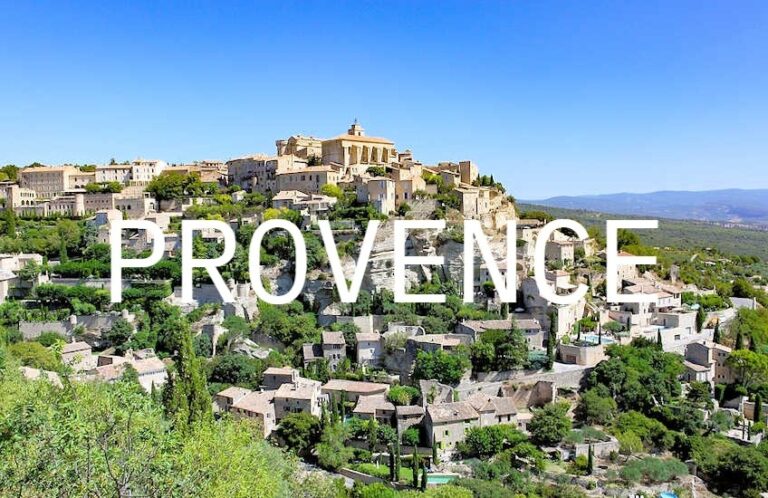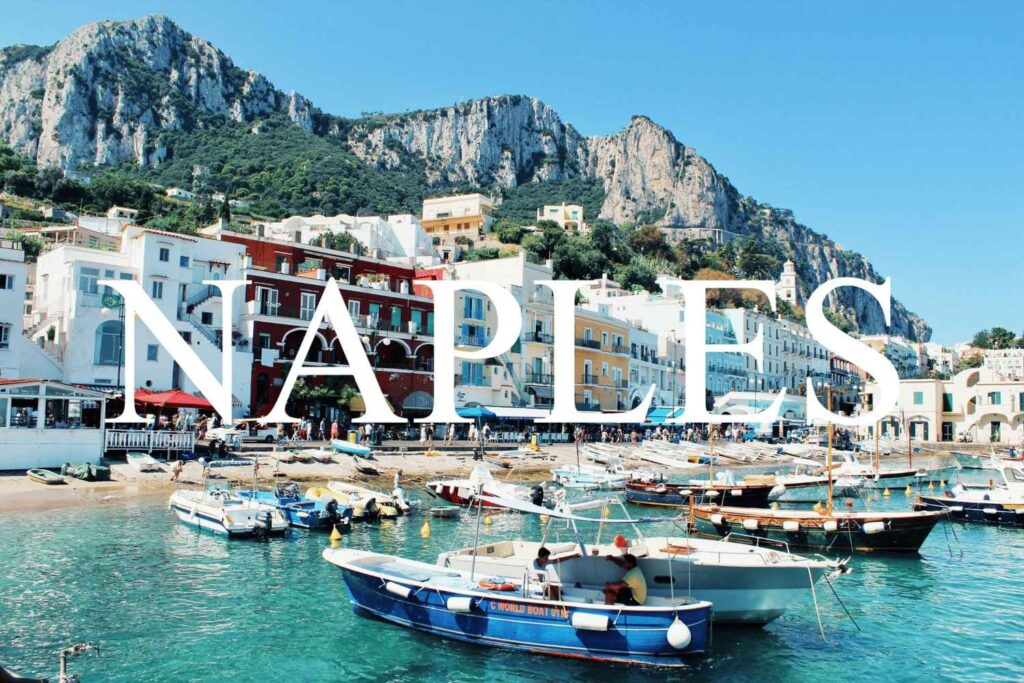
Naples, one of Italy’s most vibrant and historically rich cities, offers a captivating blend of ancient heritage, bustling street life, and world-renowned culinary delights. Known as the gateway to the stunning Amalfi Coast, Naples is a must-visit destination for travelers seeking to immerse themselves in authentic Italian culture and history.
Steeped in centuries of history, Naples is home to some of the world’s most significant archaeological sites, including the nearby ruins of Pompeii and Herculaneum. Wander through its charming old town, a UNESCO World Heritage Site, where narrow alleys open into lively piazzas, and centuries-old churches stand alongside vibrant markets. The city’s historic architecture, from the imposing Castel Nuovo to the majestic Naples Cathedral, tells stories of its rich past.
Food lovers will find Naples irresistible — it’s the birthplace of the iconic Neapolitan pizza, and the city’s bustling street markets and cozy trattorias serve up fresh seafood, rich pastries like sfogliatella, and bold espresso that fuel daily life. Whether you’re tasting traditional dishes or sipping wine with locals, Naples offers an authentic Italian gastronomic experience.
For those planning their visit, the best time to explore Naples is during the spring and early autumn months, when the weather is mild and the city’s outdoor cafes and terraces come alive. Summer brings warmth and festivals, while winter offers a quieter, more intimate glimpse of Neapolitan life.
In this guide, we’ll walk you through the best places to visit in Naples, highlight key cultural experiences, and share insider tips to help you make the most of your trip to this dynamic city.
Best Places to Visit in Naples
Pompeii and Herculaneum
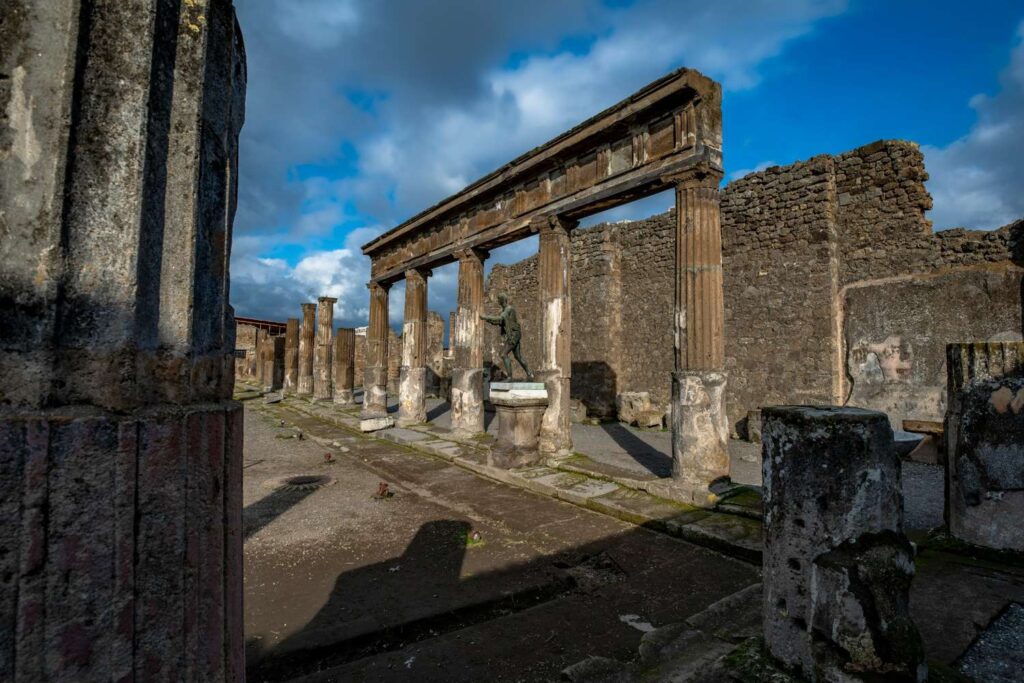
Photo by Matteo Bellia on Unsplash
Just a short trip from Naples, the ancient cities of Pompeii and Herculaneum offer a rare and fascinating glimpse into Roman civilization frozen in time by the catastrophic eruption of Mount Vesuvius in 79 AD. These UNESCO World Heritage Sites are among the most significant archaeological sites in the world, revealing remarkable insights into daily life, architecture, and culture from nearly two millennia ago.
🌟 Highlights of Pompeii
🏠 Vast Ancient City Ruins
Pompeii is the larger and more extensively excavated site, offering visitors the chance to wander through the streets, homes, temples, theaters, and forums remarkably preserved under volcanic ash.
🎨 Stunning Frescoes and Mosaics
Many buildings, like the Villa of the Mysteries and House of the Vettii, feature vibrant frescoes and intricate mosaics, providing a vivid picture of Roman art and mythology.
🏛️ Public Spaces and Amphitheaters
Explore ancient public baths, markets, and the amphitheater where gladiatorial games once entertained thousands, immersing yourself in Roman social life.
⚱️ Human History Preserved
Plaster casts of victims who perished during the eruption offer haunting reminders of the disaster’s human impact.
🌟 Highlights of Herculaneum
🏘️ Smaller but Better Preserved
Though smaller than Pompeii, Herculaneum is renowned for its exceptional state of preservation, with many wooden structures, furniture, and even food remnants intact due to the different volcanic materials that covered the city.
🏺 Luxurious Villas
Visit opulent residences like the House of the Deer and House of the Mosaic Atrium, which showcase elegant Roman design and daily life.
🛶 Well-Preserved Harbor
The ancient harbor area reveals insights into Roman trade and fishing practices.
🏛️ Less Crowded Experience
Herculaneum is often less crowded, providing a more intimate and peaceful exploration.
🚗 How to Get There
- From Naples:
Both sites are accessible by the Circumvesuviana train line. Pompeii has two stations (Pompeii Scavi – Villa dei Misteri is closest to the ruins), while Herculaneum is reached via the Ercolano Scavi station. - By Car or Tour:
Many guided tours offer combined day trips from Naples, Sorrento, or the Amalfi Coast.
🕒 Visitor Information
- Opening Hours:
Both sites are generally open daily from 9:00 AM to 7:00 PM (last entry typically one hour before closing).. - Recommended Visit Duration:
Spend at least 3-4 hours at Pompeii and 1.5-2 hours at Herculaneum to fully appreciate the sites.
💡 Travel Tips
- 🎟️ Buy Tickets in Advance:
To avoid long lines, especially in peak seasons, purchase tickets online. - 👟 Wear Comfortable Shoes:
The sites have uneven, cobblestone paths—comfortable walking shoes are a must. - 🌞 Bring Sun Protection:
There is limited shade; carry water, hats, and sunscreen. - 🎧 Consider a Guide or Audio Tour:
A knowledgeable guide or audio guide enhances understanding of the complex history and details. - 🍴 Nearby Amenities:
Numerous cafes and restaurants are located near the entrances for refreshments.
Pompeii and Herculaneum are unparalleled windows into ancient Roman life, preserved in extraordinary detail by nature’s fury. Walking their streets, admiring frescoes, and imagining life two thousand years ago is an unforgettable journey through history and human resilience. Whether you have a few hours or a full day, these archaeological marvels should top every history lover’s itinerary.
Naples Historic Center (Centro Storico)
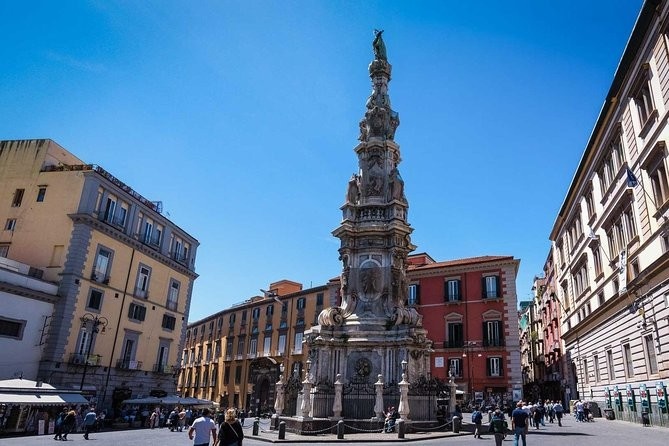
Step into the Naples Historic Center (Centro Storico), one of Europe’s largest and most vibrant old towns, where every narrow street, ancient church, and bustling piazza tells a story centuries in the making. This UNESCO World Heritage Site is the cultural and historical heart of Naples, offering visitors an unforgettable blend of history, art, religion, and authentic Neapolitan life.
🌟 Highlights of Naples Historic Center
🏰 Rich Historical Architecture
Wander through labyrinthine streets lined with medieval buildings, Baroque palaces, and Renaissance churches that showcase Naples’ layered history. Key architectural gems include the Church of Gesù Nuovo, famous for its unique façade, and the majestic Naples Cathedral (Duomo di San Gennaro).
⛪ World-Class Churches and Basilicas
The historic center boasts over 200 churches, many richly decorated with frescoes, sculptures, and artworks by renowned artists. Don’t miss Santa Chiara Monastery, with its beautiful cloisters and archaeological museum.
🖼️ Museums and Cultural Sites
Discover Naples’ artistic heritage at the Museo Cappella Sansevero, home to the incredible sculpture Veiled Christ, and the Naples National Archaeological Museum, renowned for its Pompeii artifacts.
🍕 Authentic Neapolitan Cuisine
Centro Storico is a food lover’s paradise. Enjoy traditional Neapolitan pizza at iconic pizzerias like Sorbillo and Di Matteo, or explore vibrant street food markets offering sfogliatella pastries, fried seafood, and espresso.
🎭 Bustling Streets and Markets
Experience the lively atmosphere of Spaccanapoli, the narrow main street cutting through the old town, filled with shops, artisans, street performers, and daily life that feels like stepping back in time.
🚗 How to Get There
- By Train:
Naples Central Station (Stazione di Napoli Centrale) is a short walk from the historic center. - By Metro:
Metro lines 1 and 2 serve various stops around the Centro Storico. - On Foot:
The best way to explore is on foot, allowing you to absorb the atmosphere and discover hidden gems.
🕒 Visitor Information
- Opening Hours:
The historic center is an open public area accessible 24/7. Individual churches and museums have their own opening hours. - Entry Fee:
Free to roam the streets. Entrance fees apply to museums and some churches. - Recommended Visit Duration:
Spend at least half a day to a full day to fully explore and appreciate the area.
💡 Travel Tips
- 👟 Wear Comfortable Shoes:
Streets are often cobblestone and uneven, so comfortable walking shoes are essential. - 🎒 Stay Alert:
Like many busy urban areas, keep an eye on your belongings. - 🍝 Try Local Specialties:
Don’t miss out on street foods like pizza fritta and cuoppo (fried seafood cones). - 📸 Photography:
Early mornings provide beautiful light and fewer crowds for photos. - 🗺️ Guided Walking Tours:
Consider a guided tour to learn fascinating stories and historical details behind the sights.
The Naples Historic Center is a living museum where history pulses through every corner, and the city’s vibrant spirit is unmistakable. From awe-inspiring churches to delicious street food, this neighborhood offers an authentic taste of Neapolitan culture and history that’s impossible to forget. Exploring Centro Storico is like stepping into a dynamic tapestry woven from centuries of art, faith, and everyday life.
Naples National Archaeological Museum
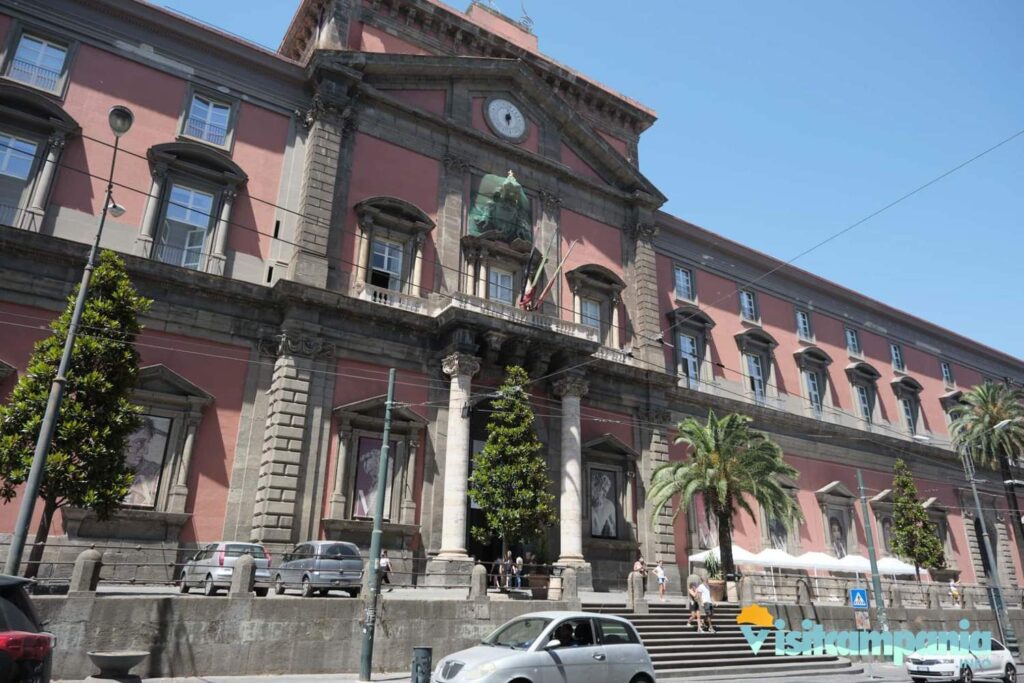
Nestled in the heart of Naples, the Naples National Archaeological Museum (Museo Archeologico Nazionale di Napoli) is a true haven for history enthusiasts, art lovers, and archaeology aficionados alike. With one of the most extensive and significant collections of Greco-Roman antiquities in the world, this museum takes you on an immersive journey through ancient civilizations. From spectacular Roman frescoes to intricately carved statues, the museum’s exhibits offer a fascinating glimpse into life in ancient Italy and beyond.
🌟 Highlights of the Naples National Archaeological Museum
• 🏛️ Classical Art and Sculpture:
Home to a wealth of classical sculptures, the museum boasts works that date back to the 2nd century BC through to the 4th century AD. Highlights include the famous Hercules Farnese, the stunning Toro Farnese, and the Venus of the Capitol, showcasing the grandeur of Roman artistic achievements.
• 🏺 Pompeian Treasures:
As a prime repository for the extraordinary archaeological finds from Pompeii, Herculaneum, and Stabiae, the museum houses a remarkable collection of frescoes, mosaics, and artifacts preserved by the catastrophic eruption of Mount Vesuvius in 79 AD. A must-see is the Famous Mosaic of Alexander, which vividly depicts the Battle of Issus.
• 🏺 Egyptian Collection:
The museum’s Egyptian section is one of the most impressive outside Egypt itself. The collection features over 2,000 items, including mummies, sarcophagi, and intricate statues, revealing the allure of Egyptian art and the links between ancient Egypt and the Roman Empire.
• 🏺 The Secret Cabinet (Gabinetto Segreto):
One of the most intriguing parts of the museum, this “secret” room houses a collection of ancient erotic art and artifacts. These items, once deemed too controversial, now offer insight into the often-taboo aspects of Roman culture and society.
• 🎨 Ancient Roman Frescoes & Mosaics:
A highlight for art lovers, the museum preserves a stunning array of frescoes and mosaics from Roman villas, showcasing the opulent décor and elaborate artistic techniques of the Roman elite.
• 🏺 Vases and Pottery:
The museum’s vast collection of ancient Greek, Etruscan, and Roman pottery reveals the artistic sophistication and everyday life of ancient cultures. From intricate painted vases to common utilitarian items, these artifacts tell the story of daily life in antiquity.
🚶 How to Get There
• By Road:
The museum is located in the historic center of Naples, just a short distance from the main train station, Napoli Centrale. You can easily take a taxi or use public transport to get to the museum, which is about a 10-minute walk from Piazza del Plebiscito.
• On Foot:
If you’re exploring the vibrant streets of downtown Naples, the museum is easily reachable by walking from the historic district. The charming narrow streets leading to the museum add to the adventure.
🕒 Visitor Information
• Opening Hours:
Open daily from 9:00 AM to 7:30 PM, except on Tuesdays (closed).
• Estimated Duration:
Allocate at least 2-3 hours for a thorough exploration of the museum, though art and history buffs may wish to spend longer.
💡 Travel Tips
• 🕰️ Best Time to Visit:
The best time to visit is in the early morning or late afternoon when the museum is less crowded. Visiting during weekdays is preferable, as weekends can get busy with local visitors and tourists alike.
• 📸 What to Bring:
Comfortable shoes for walking, a camera, and a small notebook if you enjoy jotting down notes. Although photography is allowed in most areas, check for specific rules in some of the more sensitive rooms like the Secret Cabinet.
• 📍 Nearby Attractions:
Combine your museum visit with a stroll to the nearby Spaccanapoli street, the Royal Palace of Naples, or head down to the famous Naples Cathedral. You can also take a short trip to the fascinating Capodimonte Museum, which houses a stunning art collection.
The Naples National Archaeological Museum is not just a museum; it’s an archaeological wonderland. With its remarkable collection of ancient art, sculptures, and artifacts, it offers a deep dive into the rich history of the ancient world. Whether you’re captivated by the grandeur of Roman culture or intrigued by the preserved life in Pompeii and Herculaneum, the museum is a must-visit for anyone exploring Naples. For history buffs, art lovers, and anyone with an interest in ancient civilizations, this museum stands as one of Italy’s most fascinating cultural landmarks.
Castel dell’Ovo
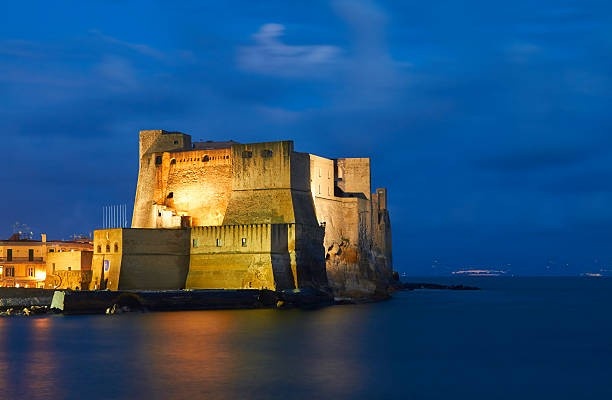
Perched on the shores of the Gulf of Naples, Castel dell’Ovo is one of the city’s most iconic landmarks, offering both a rich history and breathtaking views. This medieval fortress, whose name translates to “Castle of the Egg,” is steeped in legends and has stood the test of time as a symbol of Naples’ strength and resilience. From its origins as a Roman villa to its role as a royal residence, Castel dell’Ovo has witnessed centuries of change while remaining a beloved destination for locals and visitors alike.
🌟 Highlights of Castel dell’Ovo
• 🏰 Historical Significance:
Originally constructed in the 1st century BC by the Romans, Castel dell’Ovo has been rebuilt and expanded over the centuries. It was used by various rulers, including the Normans, Swabians, and Aragons, making it a true melting pot of medieval and Renaissance history.
• 🌊 Stunning Views of the Gulf of Naples:
One of the most striking features of Castel dell’Ovo is its panoramic location on the seafront. Visitors are treated to spectacular views of the Bay of Naples, with sights of Mount Vesuvius in the distance and the sprawling city of Naples below. The castle’s vantage point offers a unique perspective of the city’s landscape and harbor.
• 🏰 The Legendary Name – “Egg” Castle:
The name Castel dell’Ovo is said to derive from a fascinating local legend. According to folklore, the Roman poet Virgil hid a magical egg within the castle’s walls, which was believed to protect the fortress from disaster. The egg is said to have held the balance of the castle’s fate, and the legend endures as one of Naples’ most captivating tales.
• 🏛️ Architectural Blend of Eras:
The castle’s architecture is an eclectic mix, from its Roman foundations to the later medieval and Renaissance additions. Notable elements include the large central courtyard, the defensive walls, and the imposing towers. The castle’s design, while primarily military, includes ornamental features that reflect the changing tastes of its rulers.
• 🎨 Art and Exhibitions:
Today, Castel dell’Ovo houses temporary art exhibitions and cultural events, providing visitors with the opportunity to experience both historical artifacts and modern creativity within the castle’s historic walls. The blend of ancient and contemporary art makes the castle a dynamic cultural hub.
• 🚶 Scenic Walks Around the Promenade:
Surrounding the castle is a lovely seaside promenade, ideal for leisurely strolls. Here, visitors can enjoy the breeze coming off the Mediterranean Sea while soaking in the views of the castle’s towering structure and the boats in the harbor.
🚶 How to Get There
• By Road:
Castel dell’Ovo is easily accessible from most central areas of Naples. Located in the Borgo Marina district, it is about a 15-minute walk from the main Piazza del Plebiscito. You can also take a bus or taxi, both of which will bring you close to the castle.
• On Foot:
If you’re exploring the historic center of Naples, Castel dell’Ovo is a short walk from popular attractions like the Royal Palace and the Teatro di San Carlo. Enjoy the coastal breeze and views as you make your way down to the seafront.
🕒 Visitor Information
• Opening Hours:
The castle is open daily from 9:00 AM to 7:30 PM. However, it’s best to check the official website for any schedule changes or temporary closures due to special events or exhibitions.
• Estimated Duration:
Visitors typically spend 1 to 2 hours exploring the castle, although art enthusiasts and history buffs may choose to linger longer, especially if there are temporary exhibitions on display.
💡 Travel Tips
• 🕰️ Best Time to Visit:
The castle is particularly enjoyable during the spring and fall, when the weather is mild, and the crowds are lighter. Early morning visits offer a more peaceful experience, while sunset provides a stunning backdrop for photographs of the castle against the sea.
• 📸 What to Bring:
Comfortable shoes for walking, a camera to capture the amazing views, and a light jacket or sweater if you’re visiting in the cooler months. The sea breeze can be refreshing!
• 📍 Nearby Attractions:
Pair your visit with nearby highlights such as Piazza del Plebiscito, Teatro di San Carlo, and Royal Palace of Naples. You can also enjoy a relaxing boat tour around the bay, which provides a different perspective of Castel dell’Ovo.
Castel dell’Ovo stands as a magnificent testament to Naples’ rich history and strategic importance. With its legendary past, stunning architecture, and breathtaking views of the Mediterranean, it offers visitors an unforgettable experience. Whether you’re exploring its historical corridors, learning about its fascinating legends, or simply enjoying the coastal beauty, a visit to Castel dell’Ovo is a must for anyone seeking to uncover the charm of Naples.
Sansevero Chapel Museum
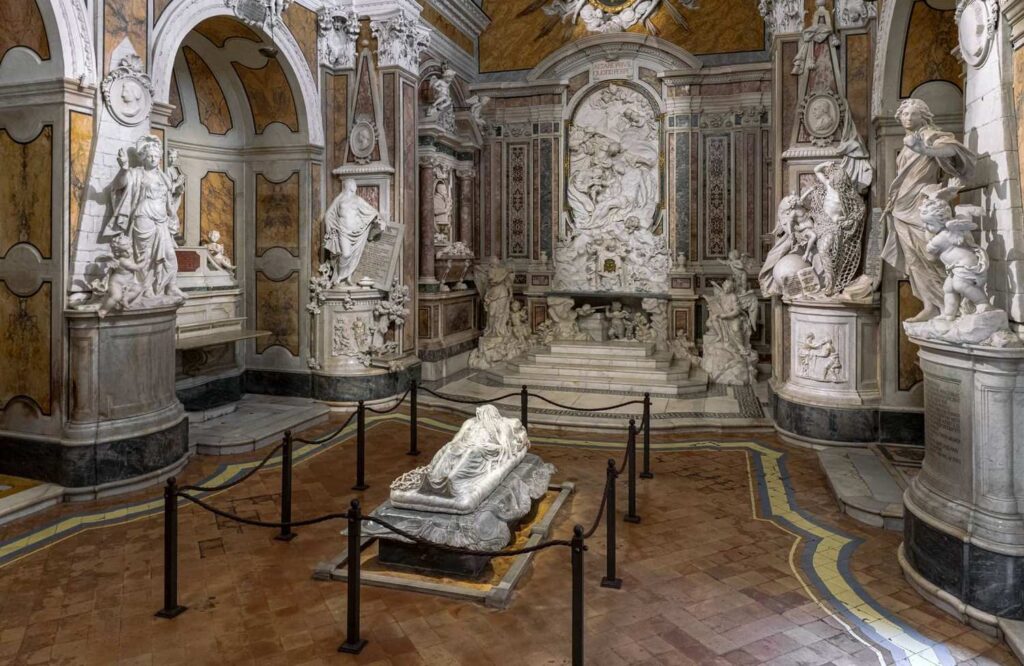
Located in the heart of Naples, the Sansevero Chapel Museum (Museo Cappella Sansevero) is one of the most extraordinary and mysterious sites in the city. Famed for its rich blend of art, history, and intrigue, this small chapel is home to some of the most stunning sculptures and hidden symbolism in all of Naples. The chapel, with its 18th-century Baroque style, was originally built as a family chapel for the noble Sansevero family, but today it’s best known for its jaw-dropping works of art and the enigmatic aura that surrounds it.
🌟 Highlights of Sansevero Chapel Museum
• 🗿 Veiled Christ – The Ultimate Masterpiece:
The star attraction of the museum is undoubtedly Giuseppe Sanmartino’s Veiled Christ (Cristo Velato). This life-sized marble sculpture, created in 1753, depicts Christ lying on a tomb with a veil so intricately carved that it looks like real fabric. The level of detail, especially the way the veil clings to Christ’s body, is so realistic that it has fascinated art critics and visitors for centuries. It is often regarded as one of the finest examples of Baroque art in Italy.
• 🕊️ The Anatomical Machines – A Chilling Mystery:
Another highlight of the Sansevero Chapel is the Anatomical Machines. These life-sized models, which are not anatomical representations of the human body but rather strange, almost macabre sculptures, depict a human figure with an intricate web of veins and arteries. According to legend, the figures were created with the help of secret scientific experiments, though their exact origins remain shrouded in mystery. These mysterious works continue to spark fascination and debate among visitors and historians.
• 🎨 The Chapel’s Baroque Art – A Feast for the Eyes:
The chapel is adorned with a wealth of Baroque frescoes and sculptures, designed to create a striking atmosphere that complements the masterpieces within. The ceilings, the walls, and the altar are richly decorated with scenes depicting religious themes, offering visitors a unique chance to experience Baroque art in its full glory.
• 🕯️ The Chapel’s Symbolism – Mysticism and Allegory:
Beyond its art, the Sansevero Chapel is steeped in mysticism. It’s said that the chapel was built with a specific esoteric purpose, with symbols of alchemy, Freemasonry, and secret knowledge woven into its design. The intricate mosaics, frescoes, and statues are full of hidden meanings, making it a site not only for art lovers but also for those intrigued by the hidden history of Naples and its aristocratic families.
• 🏛️ The Sansevero Family Tomb – History Beneath Your Feet:
Beneath the chapel lies the tomb of the Sansevero family, which adds another layer of intrigue to the site. The chapel was designed as both a place of worship and a family mausoleum, and it is said that the family, especially Prince Raimondo di Sangro, was involved in occult practices, further fueling the myths surrounding the place.
🚶 How to Get There
• By Road:
The Sansevero Chapel Museum is located in the historic center of Naples, on Via Francesco De Sanctis, just a short walk from Piazza San Domenico Maggiore. The museum is easily accessible by taxi or public transport, with several bus and metro lines stopping nearby.
• On Foot:
If you’re already exploring the historic streets of Naples, the museum is a pleasant walk from other major attractions such as Spaccanapoli, Piazza del Gesù Nuovo, and the Naples Cathedral. You’ll find the chapel nestled among the narrow, atmospheric lanes of the old town.
🕒 Visitor Information
• Opening Hours:
The museum is open daily from 9:00 AM to 7:00 PM, though it’s closed on Wednesdays. It’s recommended to check the official website for any schedule changes.
• Estimated Duration:
A visit to the chapel typically lasts around 1–2 hours, depending on how long you wish to linger over the artwork and explore the chapel’s intriguing secrets.
💡 Travel Tips
• 🕰️ Best Time to Visit:
Try to visit early in the day or later in the afternoon to avoid the crowds. The Sansevero Chapel Museum is quite popular, especially with tourists, so visiting during the quieter hours will allow you to enjoy the artwork in a more peaceful setting.
• 📸 What to Bring:
Comfortable walking shoes and a camera (though photography is often restricted in some areas). The Veiled Christ is a must-see, so be ready to capture the moment—just be aware of any photography guidelines.
• 📍 Nearby Attractions:
If you have time, combine your visit to the chapel with a stroll through the historic Spaccanapoli street, a vibrant area full of traditional Neapolitan shops and eateries. You can also visit the nearby Piazza del Gesù Nuovo, San Domenico Maggiore, or the Naples National Archaeological Museum to round out your cultural day.
The Sansevero Chapel Museum is more than just an art museum; it’s an atmospheric journey into the heart of Baroque Naples, filled with artistic brilliance, fascinating legends, and an air of mystery. Whether you’re an art enthusiast, a lover of history, or simply someone curious about the secrets of this magical city, the chapel offers an unforgettable experience. From the haunting beauty of the Veiled Christ to the strange and enigmatic Anatomical Machines, this museum is one of Naples’ most captivating treasures—a true masterpiece of art, science, and esoteric knowledge.
Piazza del Plebiscito
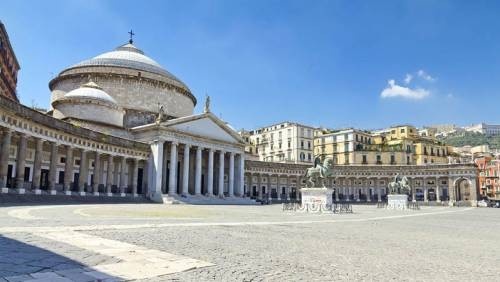
Located in the very heart of Naples, Piazza del Plebiscito is one of the most famous and grandiose public squares in Italy. With its vast open space, striking architecture, and historical significance, this iconic square has been the center of countless events throughout the city’s long history, from royal processions to political rallies. Whether you’re admiring the stately buildings, enjoying the surrounding cafes, or simply soaking in the atmosphere, Piazza del Plebiscito is a must-see destination for anyone visiting Naples.
🌟 Highlights of Piazza del Plebiscito
• 🏛️ Royal Palace of Naples – The Grand Monarch’s Residence:
On one side of the square stands the Royal Palace of Naples (Palazzo Reale), a grandiose structure that was once home to the Spanish, French, and later the Bourbon kings. This impressive palace, with its vast courtyards and ornate architecture, is a fascinating testament to Naples’ royal past. You can also visit the Royal Palace Museum inside, which showcases royal artifacts, paintings, and historic furniture.
• ⛪ Basilica of San Francesco di Paola – A Neoclassical Marvel:
At the other end of the square is the stunning Basilica of San Francesco di Paola, an imposing neoclassical church modeled after the Pantheon in Rome. With its massive dome and grand columns, it dominates the square’s skyline. Inside, the church features intricate altars, sculptures, and a serene atmosphere. The basilica is dedicated to St. Francis of Paola, the patron saint of Calabria.
• 🎭 Cultural Hub – Concerts, Festivals, and Events:
Piazza del Plebiscito is also a cultural epicenter, hosting various public events, concerts, and festivals throughout the year. Its spacious design makes it an ideal venue for large-scale performances, from operas to open-air concerts, as well as political gatherings and celebrations.
• 🌿 The Square’s Elegant Design – A Symphony of Space and Symmetry:
The square itself is a marvel of design, combining elements of classical architecture with expansive open space. The layout of Piazza del Plebiscito is symmetrical, with the Royal Palace on one side and the Basilica on the other, creating a balanced, harmonious space. At the center of the square, you’ll find a statue of King Charles III of Bourbon, which adds to the historical aura of this magnificent space.
• 🏛️ Surrounding Buildings – The Heart of Neapolitan Life:
The square is surrounded by neoclassical colonnades and elegant buildings, some of which house cafés, shops, and cultural centers. It’s a place where locals gather, tourists take photos, and street performers showcase their talents, making it a vibrant and lively spot.
🚶 How to Get There
• By Road:
Piazza del Plebiscito is located in the historic center of Naples and is easily accessible by taxi or public transportation. It’s just a short distance from Piazza del Gesù Nuovo and Via Toledo, two of the city’s most famous streets. If you’re staying in the city center, the square is within walking distance of many other key attractions.
• On Foot:
The square is very pedestrian-friendly and can be easily reached on foot from Naples’ historic center, especially from areas like Spaccanapoli or Piazza del Municipio. As you walk through the lively streets of Naples, you’ll eventually arrive at this grand open space, a welcome change from the narrow, bustling alleys.
🕒 Visitor Information
• Opening Hours:
Piazza del Plebiscito is an open public square, so it’s accessible at all times of day and night. However, the buildings around the square, such as the Royal Palace and the Basilica, have specific visiting hours. The Royal Palace is open daily from 9:00 AM to 8:00 PM, while the Basilica of San Francesco di Paola is open from 9:00 AM to 12:00 PM and from 4:00 PM to 7:00 PM.
• Estimated Duration:
A visit to the square itself can take anywhere from 30 minutes to an hour, depending on how much time you spend admiring the surroundings or exploring the Royal Palace and Basilica. If you’re attending an event or concert, you may want to allocate more time to enjoy the experience.
💡 Travel Tips
• 🕰️ Best Time to Visit:
Piazza del Plebiscito is stunning at any time of day, but it’s particularly magical at sunset when the buildings glow with the soft light. Early mornings are also a great time to visit for a more peaceful experience, before the crowds gather. Evenings often feature performances or events, adding to the lively atmosphere.
• 📸 What to Bring:
Comfortable shoes for walking, as the square and nearby attractions are best enjoyed on foot. Don’t forget your camera, as Piazza del Plebiscito is a photographer’s dream, especially with its striking architecture and historical ambiance.
• 📍 Nearby Attractions:
After visiting Piazza del Plebiscito, take a short stroll to nearby attractions like the Teatro di San Carlo, the Naples Waterfront, or the historic Galleria Umberto I. You can also enjoy a walk along Via Toledo, a bustling street with shops, cafés, and street performers.
Piazza del Plebiscito is more than just a square – it’s the cultural and historical heart of Naples. Surrounded by impressive architecture, including the Royal Palace and the Basilica of San Francesco di Paola, the square offers a glimpse into the grandeur of the city’s past. Whether you’re there to admire the art, attend a cultural event, or simply relax and people-watch, Piazza del Plebiscito is an essential stop for anyone exploring the beauty and vibrancy of Naples.
Via Toledo and Galleria Umberto I
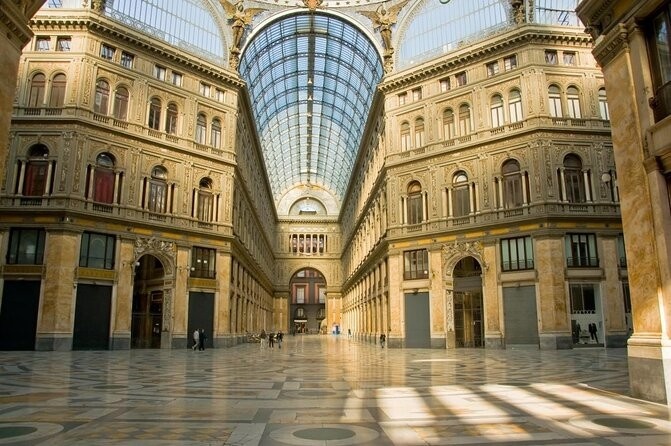
One of the city’s most famous and lively streets, Via Toledo is the beating heart of Naples when it comes to shopping, culture, and entertainment. Stretching from Piazza del Plebiscito all the way to Piazza Dante, this bustling thoroughfare offers a blend of old-world charm and modern flair. Whether you’re window shopping, enjoying a traditional Neapolitan coffee, or simply taking in the local life, Via Toledo provides a true slice of Naples.
🌟 Highlights of Via Toledo
• 🛍️ Shopping Paradise – From High Street to Boutique Treasures:
Via Toledo is known for its wide array of shops, ranging from international brands and department stores to charming boutiques. Whether you’re hunting for the latest fashion trends, unique artisan goods, or souvenirs, this street has it all. Popular shopping stops include La Rinascente department store and Coin, offering everything from clothing to cosmetics and electronics.
• 🍕 Neapolitan Cafés and Street Food – A Taste of Naples:
Along Via Toledo, you’ll find plenty of cafés, pastry shops, and street vendors offering a taste of Naples. Try a traditional sfogliatella (a delicious pastry) with a caffè espresso, or grab a slice of pizza margherita from one of the many pizzerias nearby. It’s the perfect place to sit, people-watch, and soak in the Neapolitan way of life.
• 🏛️ Historic Buildings – A Walk Through Time:
While the street itself is a lively commercial hub, Via Toledo is also rich in historical and architectural gems. Some of the buildings along the street date back to the 16th century, showcasing Naples’ fascinating blend of Renaissance, Baroque, and modern design. Be sure to look up as you stroll – you’ll spot fascinating facades and details on the upper levels of the buildings.
• 🛒 Cultural Landmarks – From Markets to History:
Via Toledo used to be the location of a famous street market, giving it a long history as a commercial center. Today, it’s a must-visit for those who want to experience both the pulse of modern Naples and its historical roots. While the street is bustling with activity, you’ll often hear street performers, musicians, and vendors adding to the lively atmosphere.
🌆 How to Get There
• By Road:
Via Toledo is easily accessible from most parts of Naples, especially the historic center. It’s a short walk from Piazza del Plebiscito, and public transport options such as the Metro Line 1 have a stop right at Toledo Station, making it easy to reach from other parts of the city.
• On Foot:
The street is pedestrian-friendly and easily explored on foot. It connects important landmarks such as Piazza del Plebiscito, Piazza Dante, and the famous Spaccanapoli street. Take your time as you explore the mix of shopping, culture, and history.
🏛️ Galleria Umberto I – Naples’ Grand Shopping Arcade
A short stroll down Via Toledo will bring you to Galleria Umberto I, a stunning example of 19th-century architecture and one of the city’s most beloved landmarks. This elegant shopping arcade, with its intricate glass dome and decorative mosaics, has been a symbol of Naples’ sophistication and grandeur since it opened in 1891.
🌟 Highlights of Galleria Umberto I
• 🏛️ Architectural Beauty – A Neo-Renaissance Masterpiece:
Designed by architect Eugenio Mele, the Galleria Umberto I is a breathtaking blend of neo-Renaissance and Art Nouveau styles. The soaring glass dome, with its intricate ironwork and colorful mosaics, is an architectural marvel, letting natural light flood the central space. The elegant columns, marble floors, and grand staircases all add to the arcade’s opulent charm.
• 🛍️ Boutiques and Cafés – A Taste of Elegance:
Today, Galleria Umberto I is home to a mix of high-end boutiques, cafés, and restaurants, making it an ideal stop for both shopping and relaxation. You can browse designer shops, enjoy a glass of wine in one of the chic cafés, or simply admire the stunning architecture while people-watching. It’s the perfect place to slow down and soak in the elegance of Naples.
• 🖼️ Cultural Events and Exhibitions – Art in the Heart of the City:
The Galleria also hosts various art exhibitions, cultural events, and performances throughout the year. Its central location makes it a popular venue for both locals and tourists. The gallery itself often feels like a work of art, making it a delightful stop even if you’re not in the mood for shopping.
• 🌟 The Galleria’s Dome – A Glimpse of the Skies:
The dome of Galleria Umberto I is one of the most striking features of the building. Its intricate glass and iron structure rises over the central space, providing a stunning view of the sky above. The dome, which measures an impressive 55 meters in height, is a perfect example of 19th-century engineering and design.
🚶 How to Get There
• By Road:
Galleria Umberto I is located at the intersection of Via Toledo and Piazza del Plebiscito, in the heart of Naples’ shopping district. It’s easily accessible by foot from major landmarks and public transport.
• On Foot:
If you’re exploring Via Toledo, Galleria Umberto I is just a short walk away. The arcade is right near Teatro di San Carlo and Piazza Plebiscito, so it’s easy to integrate into a tour of Naples’ most famous areas.
🕒 Visitor Information
• Opening Hours:
Galleria Umberto I is open daily from 10:00 AM to 7:00 PM, though the individual shops may have their own hours. The arcade itself remains open, and you can explore its architecture and enjoy the ambiance at any time of day.
• Entry Fees:
Entry to the Galleria is free, but if you wish to shop or dine, individual shops and restaurants will have their own pricing.
• Estimated Duration:
A visit to Galleria Umberto I can last anywhere from 30 minutes to an hour, depending on whether you’re shopping, dining, or simply admiring the architecture. You can also combine it with a visit to nearby attractions like Teatro di San Carlo or Royal Palace of Naples.
💡 Travel Tips
• 🕰️ Best Time to Visit:
The Galleria is particularly beautiful in the late morning or early afternoon when the natural light pours through the glass dome. It’s also a great place to stop for a coffee in the afternoon, as the atmosphere becomes lively but not overly crowded.
• 📸 What to Bring:
Comfortable shoes, especially if you plan to shop or explore the surrounding areas. Don’t forget your camera – the Galleria’s intricate details and elegant design make it a photographer’s dream.
• 📍 Nearby Attractions:
While in the area, make sure to visit Teatro di San Carlo, one of the oldest and most prestigious opera houses in Europe, or take a short walk to Piazza del Plebiscito and Royal Palace. If you have time, check out Spaccanapoli, the narrow street that cuts through the heart of Naples’ historic district.
Both Via Toledo and Galleria Umberto I offer a perfect blend of Naples’ vibrant culture, history, and modern elegance. Whether you’re shopping for Italian fashion, savoring a coffee in a charming café, or simply admiring the architectural beauty, these two landmarks provide an unforgettable experience. They represent the heart of Naples, where past and present come together in a vibrant, ever-moving harmony.
Mount Vesuvius
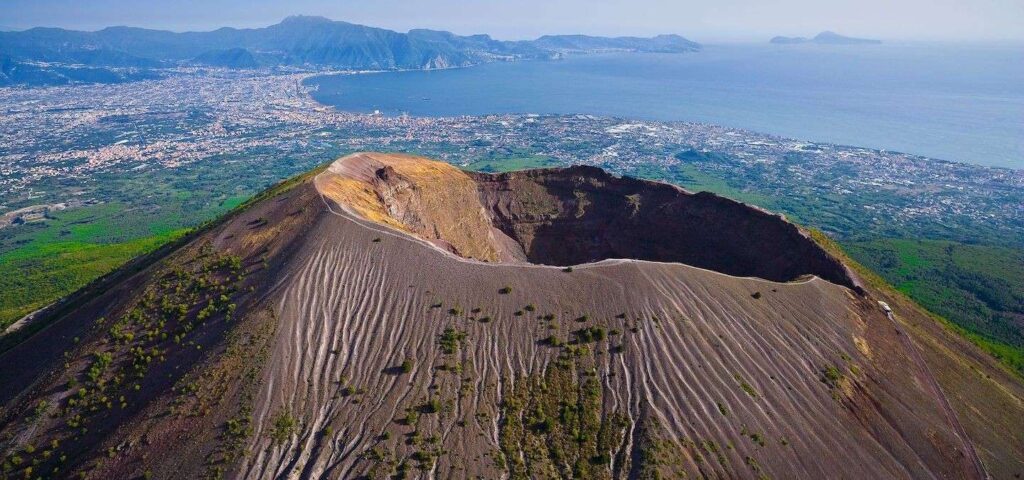
Towering over the Bay of Naples, Mount Vesuvius is one of the most famous—and active—volcanoes in the world. Its eruption in AD 79 famously destroyed the ancient cities of Pompeii, Herculaneum, and Stabiae, leaving behind a legacy that still captures the imagination of millions today. Though it has remained dormant since its last eruption in 1944, Vesuvius continues to be a symbol of both nature’s destructive power and the resilience of human civilization. Whether you’re a history lover, nature enthusiast, or adventure seeker, a visit to Vesuvius offers a breathtaking experience.
🌟 Highlights of Mount Vesuvius
• 🏞️ Hike to the Crater – An Active Volcano Experience:
One of the main attractions of Mount Vesuvius is the opportunity to hike up to the crater. The climb is moderately challenging but rewarding, as you’ll have stunning panoramic views of the Bay of Naples, the surrounding towns, and the ancient cities below. Once at the top, you can peer into the volcanic crater itself, witnessing the immense scale of the volcano’s mouth and feeling the presence of this natural giant up close.
• 🌋 The View Over Pompeii and Herculaneum – A Walk Through History:
From the summit, the view of the nearby archaeological sites of Pompeii and Herculaneum is awe-inspiring. You can clearly see the outlines of these once-thriving Roman cities, frozen in time by the volcanic eruption of AD 79. The sight makes the connection between the eruption and its catastrophic impact all the more real. A visit to Vesuvius gives you a powerful perspective on the scale of the disaster that reshaped the ancient world.
• 📜 Vesuvius and Its Legacy – From Destruction to Discovery:
Mount Vesuvius is intimately tied to the story of Pompeii, Herculaneum, and Roman history. The eruption buried these cities under layers of volcanic ash and pumice, preserving them for centuries. Today, you can explore the ruins of these cities and learn more about daily life in the Roman Empire before the eruption. Vesuvius itself is a living monument to one of the most significant natural disasters in history.
• 🌱 Flora and Fauna of Vesuvius – Nature’s Resilience:
Though Vesuvius is known for its fiery eruptions, the volcano’s slopes have become a rich environment for unique flora and fauna. The lower slopes of the mountain are home to vineyards that produce the famous Lacryma Christi wine. There are also hiking paths through the park where you can see diverse plant species, along with birds and other wildlife. Nature has rebounded from the eruptions, creating a stark contrast between the destructive power of the volcano and its role as a thriving ecosystem.
🚶 How to Get There
• By Road:
Mount Vesuvius is located around 9 kilometers (5.5 miles) east of Naples. You can reach it by car or take a shuttle bus from the Ercolano or Pompeii stations, both of which are easily accessible by train from Naples. The road to the summit is well-maintained, and there are parking lots near the base of the mountain.
• By Public Transport:
From Naples Central Station, take a train to Ercolano (a 20-minute journey). From there, you can catch a bus that will take you to the foot of the mountain. Alternatively, there are also guided tours that depart from Naples, combining transportation and a guided hike to the crater.
• On Foot:
The hike itself is around 30-45 minutes depending on your pace and fitness level. The path is well-marked, with some sections that are steeper but manageable for most visitors. Along the way, you’ll encounter scenic views and opportunities for great photos.
🕒 Visitor Information
• Estimated Duration:
Plan to spend 2 to 3 hours at Mount Vesuvius, including the hike to the crater, exploring the summit, and enjoying the views. If you plan to visit the surrounding areas, like Pompeii or Herculaneum, expect additional time for those excursions.
💡 Travel Tips
• 🕰️ Best Time to Visit:
The best time to visit Mount Vesuvius is during the spring and autumn months (April to June and September to October). The weather is mild, the skies are clear, and the hiking conditions are optimal. Summer can be quite hot, so it’s better to visit early in the morning or late in the afternoon.
• 🥾 What to Bring:
Wear sturdy hiking shoes, especially if you plan to trek to the crater. Bring a water bottle, a hat, sunscreen, and a camera to capture the stunning views. The summit can get windy and chilly, even in summer, so packing a light jacket is a good idea.
• 🧭 Guided Tours:
If you’re new to hiking or prefer more in-depth information about the volcano’s history and geology, consider booking a guided tour. Guides offer fascinating insights into Vesuvius’ eruption, its impact on nearby cities, and the ongoing scientific monitoring of the volcano.
• 📍 Nearby Attractions:
After visiting Vesuvius, take a detour to explore the archaeological sites of Pompeii and Herculaneum, both of which provide a deeper understanding of the historical significance of the eruption. You can also visit the Vesuvius Observatory, where researchers study the volcano’s activity, or enjoy the charming town of Herculaneum.
Mount Vesuvius is not just a mountain—it’s a living testament to the power of nature and a central part of Naples’ history. A visit to Vesuvius offers a rare opportunity to stand on the edge of an active volcano, look into its crater, and reflect on its monumental impact on ancient civilization. Whether you’re interested in geology, history, or simply breathtaking views, Vesuvius provides an unforgettable experience that brings you face to face with one of the world’s most famous natural landmarks.
Naples Underground (Napoli Sotterranea)

Beneath the bustling streets of Naples lies a fascinating and mysterious world—Napoli Sotterranea, or the Naples Underground. This vast network of tunnels, chambers, and ancient passageways tells the story of Naples’ past in a way few other places can. From ancient Greek and Roman origins to medieval and modern uses, the underground city offers a glimpse into the ever-evolving layers of Naples’ rich history.
Visiting Napoli Sotterranea is like stepping back in time—exploring 2,400 years of history under the feet of the modern city. It’s an experience that combines archaeology, mystery, and adventure, making it a must-see for anyone wanting to understand the full depth of Naples’ cultural heritage.
🌟 Highlights of Naples Underground
• 🏛️ Ancient Greek and Roman Origins – A Foundation of the Past:
Naples Underground is believed to have been first excavated by the ancient Greeks around the 5th century BC, making it one of the oldest underground cities in Europe. The Greeks originally dug tunnels for water storage and to create a series of underground chambers. Over time, the Romans expanded these systems for use as aqueducts, catacombs, and even a network of living spaces. Walking through these passages, you’ll find remnants of these ancient uses, with original brickwork, inscriptions, and cisterns still visible.
• ⛪ The Medieval and Renaissance Eras – A City Within a City:
As Naples grew during the medieval and Renaissance periods, the underground system evolved. It was used for everything from hiding treasures to sheltering civilians during times of war. The labyrinthine passages also served as crypts, where Naples’ noble families were laid to rest. Some of these chambers still hold traces of the city’s past, with frescoes, ancient tombs, and relics scattered throughout.
• 🌊 The Ancient Water System – Naples’ Hidden Aqueducts:
One of the most impressive features of Napoli Sotterranea is its ancient water system. The underground aqueducts, which date back to the Roman era, once supplied the city with fresh water. Today, you can still walk through these tunnels, which were used to transport water to the homes and fountains of ancient Naples. The intricate system is a testament to Roman engineering and their ability to build structures that have lasted for millennia.
• 💀 Naples’ Crypts and Catacombs – Sacred Spaces Beneath the Streets:
Deep within Napoli Sotterranea, you’ll encounter ancient crypts and catacombs, including the Catacombs of San Gennaro (in a nearby location), which hold significant religious and historical importance. The underground crypts served as burial sites for Naples’ elite and saints, and some are adorned with fascinating frescoes and mosaics that showcase early Christian art. The eerie, yet awe-inspiring atmosphere provides a unique insight into the sacred history of the city.
• ⚔️ Secret Tunnels and War Shelters – The War Effort Below Ground:
During World War II, the underground passages were used as shelters from bombings. You can see how these tunnels were adapted during the war, with makeshift beds, old artifacts, and remnants from the 1940s. This part of Napoli Sotterranea offers a poignant reminder of Naples’ wartime history, giving visitors a deeper understanding of the resilience of the city’s people.
🚶 How to Get There
• By Road:
Naples Underground is located in the historic center of Naples, at Piazza San Gaetano, which is easily accessible by foot from many popular landmarks. It’s just a short walk from Spaccanapoli or Piazza del Plebiscito. You can also take public transportation to Università Metro Station (Line 1) or Piazza Cavour (Line 2), both of which are about a 10-minute walk from the entrance.
• On Foot:
The best way to explore the historic center of Naples is on foot, as many of the city’s landmarks, including Napoli Sotterranea, are within walking distance of each other. Once you arrive at Piazza San Gaetano, you’ll find the entrance to the underground tours easily marked.
🕒 Visitor Information
• Opening Hours:
Napoli Sotterranea is open daily from 10:00 AM to 6:00 PM. The last tour of the day typically starts at 5:00 PM, so it’s advisable to arrive earlier to ensure a spot on the guided tour.
• Estimated Duration:
A typical tour of Napoli Sotterranea lasts about 1 hour. The tour is guided, so you’ll learn about the history and significance of the various tunnels and chambers along the way.
💡 Travel Tips
• 🕰️ Best Time to Visit:
Napoli Sotterranea is a popular attraction, so it’s best to visit in the early morning or late afternoon to avoid crowds. If you’re visiting in the summer months, consider coming in the late morning or early evening when the temperatures underground are cooler.
• 👟 What to Bring:
Wear comfortable shoes, as the underground pathways can be uneven, narrow, and sometimes slippery. A light jacket is also a good idea, as the temperature underground is typically cooler than above ground, even in summer.
• 🧳 Tour Tips:
Tours are conducted in small groups, and while English-speaking guides are available, booking tickets in advance is highly recommended, especially during peak tourist seasons. The guides are knowledgeable and provide fascinating insights into the historical and archaeological significance of the tunnels and chambers.
📍 Nearby Attractions
After your underground adventure, explore the surrounding area, which is rich in history and culture:
• Spaccanapoli – This famous street cuts through the heart of Naples’ historic center and is perfect for those who want to experience the authentic charm of the city, from artisan shops to pizzerias.
• San Gregorio Armeno – Known for its famous nativity scene workshops, this street is a must-see during the Christmas season.
• Naples Cathedral (Duomo di San Gennaro) – Just a short walk from Napoli Sotterranea, this cathedral is home to the relics of Naples’ patron saint, San Gennaro.
Naples Underground (Napoli Sotterranea) offers an unforgettable experience that reveals the hidden side of the city’s history. It’s not just a tour of tunnels and chambers; it’s a journey through time. From ancient Greek cisterns to medieval catacombs and World War II shelters, Napoli Sotterranea showcases the depth and complexity of Naples’ past. Whether you’re a history enthusiast, an archaeology lover, or simply looking for a unique adventure, Naples Underground is an absolute must-see.
Try Authentic Neapolitan Pizza

No visit to Naples would be complete without tasting its most iconic culinary creation: authentic Neapolitan pizza. Renowned worldwide for its simplicity, quality ingredients, and rich history, Neapolitan pizza is a true representation of Naples’ gastronomic tradition. Born in the heart of the city in the 18th century, this pizza is recognized by the Associazione Verace Pizza Napoletana (AVPN) for adhering to strict guidelines that preserve its authenticity. If you want to experience the true flavor of Naples, there’s no better place to indulge than at one of the many pizzerias scattered throughout the city.
🌟 Highlights of Neapolitan Pizza
• 🍅 Simple Yet Delicious Ingredients – The Heart of Neapolitan Pizza:
Neapolitan pizza is all about quality, fresh ingredients. The dough is made from flour, water, yeast, and salt, and it’s left to rise for a minimum of 8 hours. The tomato sauce comes from the San Marzano tomatoes, grown in the volcanic soil of Mount Vesuvius, adding a distinctive flavor. Topped with fresh mozzarella di bufala, basil, a drizzle of olive oil, and a pinch of salt, this pizza is a perfect balance of flavors.
The Margherita, with its simple toppings of tomato, mozzarella, basil, and olive oil, is the most classic representation of Neapolitan pizza, but you’ll also find the Marinara, topped with tomato, garlic, oregano, and olive oil—no cheese.
• 🍞 The Dough – The Secret to Perfection:
The dough of a Neapolitan pizza is what sets it apart from other types. It’s kneaded by hand and stretched into a thin, soft base that cooks quickly in a wood-fired oven. The pizza should be soft in the center and slightly crispy on the edges, with charred spots from the high heat of the oven. This cooking method is essential to achieving the iconic fluffiness and lightness of Neapolitan pizza.
• 🌱 Freshness of Ingredients – The Importance of Quality:
The key to an authentic Neapolitan pizza lies not just in the dough but in the ingredients themselves. The tomato sauce must be made from San Marzano tomatoes, which are sweet, rich, and slightly tangy. Mozzarella di bufala, made from the milk of water buffalo, is soft and creamy, adding a distinct flavor that’s hard to replicate. The fresh basil leaves and a drizzle of extra virgin olive oil complete the perfect pizza experience.
🚶 Where to Try Authentic Neapolitan Pizza
Naples is filled with pizzerias that take great pride in serving authentic Neapolitan pizza. Some of the most famous spots where you can try this legendary dish include:
• 🍕 L’Antica Pizzeria da Michele
Often considered the birthplace of Neapolitan pizza, this pizzeria has been serving traditional pies since 1870. With its no-frills approach, Da Michele focuses on perfecting just two types of pizza: Margherita and Marinara. Be prepared for a queue, but the wait is absolutely worth it.
• 🍕 Pizzeria Sorbillo
Another iconic pizzeria in Naples, Sorbillo is known for its huge, perfectly balanced pizzas. The restaurant’s family history in the pizza business goes back generations, and their dedication to using high-quality ingredients and traditional techniques makes every bite an unforgettable experience.
• 🍕 Pizzeria Di Matteo
A local favorite in the heart of the historic center, Di Matteo has been serving delicious pizzas since 1936. It’s a great spot to try a traditional pizza while soaking up the bustling atmosphere of Naples.
• 🍕 La Notizia
La Notizia is a more modern take on Neapolitan pizza, with a focus on creativity while sticking to the basics. Chef Enzo Coccia has won numerous awards for his pizzas and his restaurant is considered one of the best places to taste innovative, yet authentic, pies.
• 🍕 Pizzeria Starita
Starita is famous for its fritta, or fried pizza, as well as its traditional wood-fired pizza. Located in the Materdei district, it’s a great place to try something a little different while still enjoying the classics.
🕒 Visitor Information
• Opening Hours:
Pizzerias in Naples typically open for lunch around 12:00 PM and stay open until 3:00 PM, then reopen for dinner from around 7:00 PM to 11:00 PM. It’s advisable to make reservations if you’re visiting popular spots like Da Michele or Sorbillo, as they can get crowded, especially in the evening.
• Entry Fees:
Pizza prices vary depending on the pizzeria and the toppings you choose, but most Margherita pizzas range from €5 to €10, while specialty pizzas or gourmet toppings can cost a bit more.
💡 Travel Tips
• 🍽️ What to Expect:
When you order a Neapolitan pizza, expect a personal-sized pie that’s light, fluffy, and perfectly balanced in flavor. It’s typically eaten with a fork and knife, though locals may fold the pizza in half for easier eating. The crust will be slightly charred, and the center will be soft with a bit of a chewy texture.
• 🕰️ Best Time to Visit:
The best time to try Neapolitan pizza is in the evening, when locals head out for their traditional dinner. If you’re looking to avoid crowds, try visiting pizzerias for lunch or in the earlier hours of the evening.
• 🍷 Pairing with Wine:
Neapolitan pizza pairs wonderfully with local wines such as Lacryma Christi (a white or red wine grown on the slopes of Mount Vesuvius) or a Campanian Aglianico for red wine lovers. A cold limoncello after your meal is a perfect way to end your pizza experience.
Eating authentic Neapolitan pizza is not just about tasting a meal—it’s about experiencing a piece of Naples’ soul. With its fresh ingredients, simple preparation, and centuries-old tradition, Neapolitan pizza is an essential part of any visit to the city. Whether you’re sitting in a historic pizzeria like Da Michele or trying something a bit more modern at La Notizia, each slice will transport you closer to the heart of Naples’ culinary culture. Don’t leave Naples without savoring this iconic dish—it’s a must-do for any food lover!
Best Time to Visit Naples
Spring (March to May)
Spring is one of the best times to visit Naples, with pleasant weather, blooming flowers, and fewer tourists. It’s ideal for sightseeing and exploring outdoor markets.
Summer (June to August)
Summer is warm and lively, with plenty of festivals and events. While it’s the busiest tourist season, it’s perfect for beach lovers and those wanting to explore the Amalfi Coast nearby.
Autumn (September to November)
Autumn offers cooler temperatures and fewer crowds. The city is vibrant with harvest festivals, making it a great time for foodies and culture seekers.
Winter (December to February)
Winter in Naples is mild compared to northern Europe. Although some tourist spots may have shorter hours, it’s a peaceful time to enjoy local life and festive holiday traditions.
Insider Tips for Visiting Naples
- Stay vigilant with your belongings, especially in crowded areas.
- Use public transport or walk to fully experience the city’s lively streets.
- Try local street food like sfogliatella, espresso, and fried pizza.
- Book tours to Pompeii and Vesuvius in advance to avoid last-minute hassles.
Final Thoughts
Naples is a city of contrasts — ancient and modern, chaotic and charming, delicious and historic. From exploring ruins frozen in time to savoring the best pizza in the world, Naples promises an unforgettable adventure for every traveler. Choose your season wisely, plan ahead, and get ready to fall in love with this spirited Italian city.

I’m Shreyash Mhashilkar — a full-stack developer by profession, and a passionate explorer of the future at heart.
With a strong foundation in both front-end and back-end , I spend my days building websites and applications that are not just functional, but scalable, intuitive, and user-focused.


